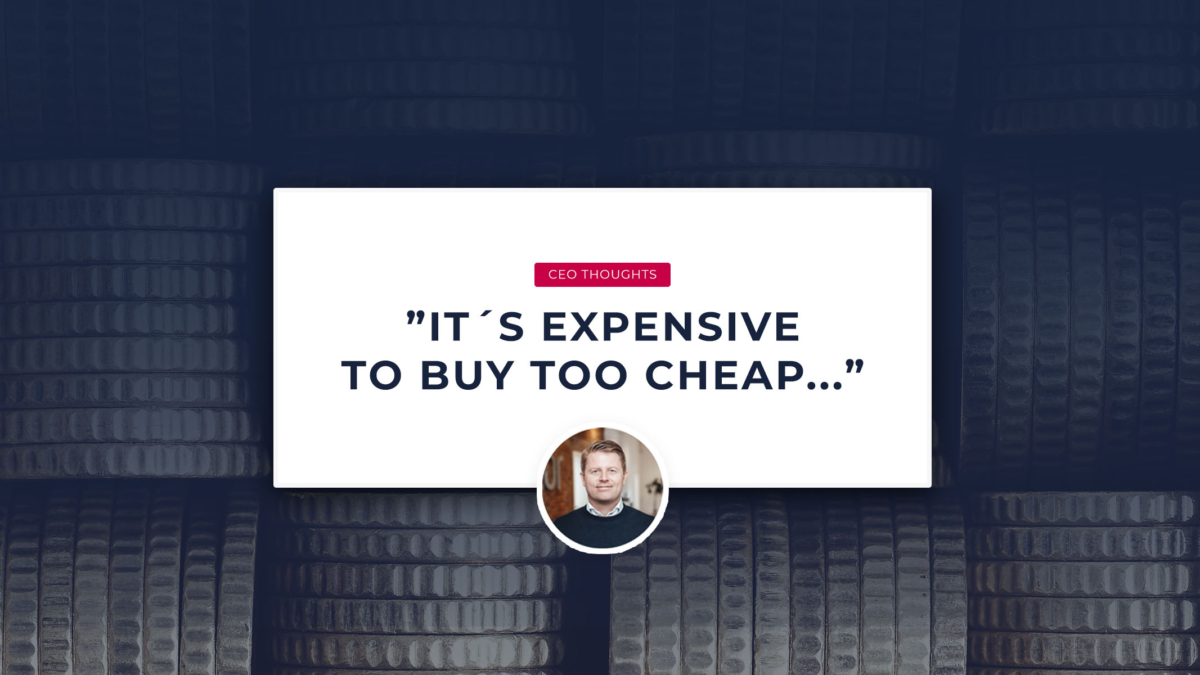CEO Thoughts: It’s expensive to buy too cheap
Aug 26, 2020 |

Forget about the price when choosing technology. All too often, the nominal price, and the invoice that follows, determines our choice in tech. The consequence is a polluted decision-making basis that rarely harmonizes with the ambition behind.It is expensive to buy too cheap!
A claim? Perhaps. But in many contexts of life, there is a noticeable connection here.
The cheap printer uses way too much ink and is expensive to operate. The shirt appears dingy after a few washes and requires more frequent shirt purchases. Or the all-inclusive holiday overlooking… your neighbor’s wall.
If it’s too good to be true, then there’s probably something about it!
However, when it comes to software this connection can be harder to spot, let alone understand, and especially in the short run. When the supplier’s energy is good, their presentation concludes that “we know it all”, and their prices are low, then you are on safe ground, right? No, definitely not. To exemplify think of a pair of butterfly wings that end up in an economic Tsunami. It is not only expensive to choose the wrong software, the wrong choice can both make the concrete technology fail and pollute the digital infrastructure which then becomes a business–critical matter.
Let me try to illustrate it for you…
Price is something we all understand. For most physical products, we seem to understand and accept that there are different price levels. For example, when it comes to cars a Renault is cheaper than a Bentley, even though they both solve the same purpose. Or when it comes to designer furniture, we understand that Arne Jacobsen is more expensive than similar functionality in IKEA.
There is nothing wrong with these differences in pricing. And fortunately depending on purpose, ambition, and of course your wallet, there is a market for both.
But how do we spot Renault vs. Bentley within the software? We can start with the misconception of all misconceptions that when you sell software, it’s just air and therefore not a real product. We just turn the technology on and off, and hosting is easy peasy, so what’s the problem?
The problem is the same as in all other aspects of the business. A company not only consists of a product or service but of people who support the company’s services from development, consulting, and support to cleaning and lunch schemes.
Arriving safely on your journey
As the case is with the two market poles in the physical world, it is also natural in the world of technology that there are companies that believe in high volume and low price. It is perfectly legal, but the perception is the other way around. For example, if two technologies solve the same problem on paper, why not then choose the cheapest, because you cannot see if it is a Renault? In reality, it is probably more perception of arriving from A to B without the distinction of how the journey will be and whether you arrive safely.
In this case, it is important to emphasize that buying cheap doesn’t necessarily equal something bad. But if the ambition is to buy a designer sofa or a holiday with an ocean view, then the ambition must match the delivery and the supplier behind. Contrary to the designer sofa that you get to bring home, the software is often something you rent (SaaS), and therefore it is crucial in the choice of supplier that they run a healthy business and have a financial ability that doesn’t break down due to the economic situation in society. It can only be in the customer’s interest to work together in a healthy ecosystem of dominoes that make up the customer’s business altogether.
It is not enough that the supplier demonstrates enthusiasm. The supplier should also demonstrate the ability to innovate both on existing products and the addition of new ones as the world changes. In the case of technology, it indisputably moves at a very high speed and in a trinity of innovation, law, and market. The supplier must invest in the competencies that partly match the complexity of the technology and partly match or complement the customer’s competencies. It is also important that this is done with ambitions regarding quality and depth. Businesses are like a household. If there is no balance in the economy, then pressure arises which affects the enthusiasm and limits the opportunities for creating a good framework for the customer.
With software, it entails going more in–depth with the requirements that are up against one’s own business. And it’s about understanding that when you choose between technologies, you do so with open eyes and more as a selective choice of technology rather than price. The most dangerous thing is to be seduced by buzzwords and pricing that are too good to be true.
References and return of investment
If you do not have the necessary insights or competencies employed in your organization, you should dedicate a budget towards an external partner who can help uncover and advise in the span between ambition and choice of technology. An A/B split test is rarely the solution, as it on the one hand offers you a snapshot and on the other hand, makes it difficult to underline a clear-cut conclusion in the long run.
It is important to have trust in your supplier as well as obtaining references. It is also crucial to choose references that can act as strong peers and who share the same level of ambition and complexity. If you are an international company that has an online turnover of billions, then it is a gigantic own goal to obtain references from a small national company and thinking that as long as we both have a digital turnover, then it is probably the same thing we need. Nothing could be more wrong.
In other words. As much as we understand the nominal part of a price, just as unimportant is it. When it comes to technology, it is far more relevant to focus on price return. Ask yourself the classic question: What do I want to achieve and avoid? It will never be preferable to pay 100 DKK for a price return of 200 DKK if you can obtain a price return of 5,000 DKK by paying 1,000 DKK. Nor is it preferable to pay a lower price if it limits your agility or reduces the degree of automation. This is just a postulate, but there might be some truth to it.
Two things that often reflect the difference between low and high costs are first of all standard versus agility. The other is organizational commitment, and dedicated resources to proactively work with the technology up against business. Herein lies the degrees of freedom and the ability to achieve higher returns, which makes the difference between yield and price much more attractive.
Conclusively, a technology supplier cannot get away with only delivering building blocks but must have the ability and competence to understand and supplement the overall ecosystem to a much greater extent. The building block itself only creates value if we understand the context in which it is part of; that the customer is building a cathedral.
Key takeaways
- If it’s too good to be true, then there’s probably something about it!
- It’s not just about getting from A to B but having a safe journey.
- Your ambition should always match your budget and the price is not just an invoice.
- Recognize your strengths and supplement them with external ones.
- Use references in your decision-making, but make sure they are peers.
- Choose a technology provider who understands the business.
Related Content
You might also like
Let us show you what you can achieve with premium personalization


A Raptor expert can share more about the product and answer any questions you have.

